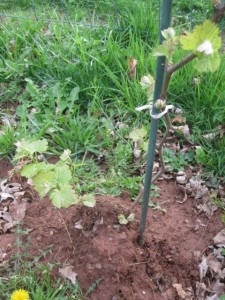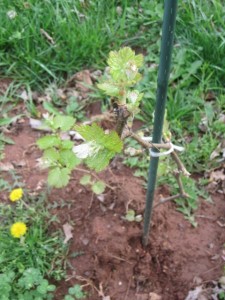The Perils of an Early Spring
We arrived home Sunday afternoon to find that the vines in our Fairfax vineyard were blooming in a magnificent way. I had pruned them during the winter, when they were still dormant, and have been wondering ever since if I had cut cut them back too severely. When I saw them on Sunday, though, I felt vindicated. Yes! Yes ! They would be up to the first wire (30 ” – or maybe 36″, I actually haven’t put the trellis in yet) in no time flat, I assumed.

The Fairfax vineyard is a bit overrun with weeds right now, but you can see the leaves on this vine if you look closely.
I couldn’t have been happier. Until I showed the vines to my wife, the Vineyard Goddess.
“Well, that’s good and bad,” she said. Good, of course, because the vines looked so healthy and productive. But mostly bad, because, it’s still March and we could have some frost ahead of us. The bud break I observed on my vines had come very early in the season. And when she glanced over my shoulder at this post, she added another rule of thumb for vineyard management: “March will always be too early for bud break.”
And of course she was right. (She’s pretty much always right. Thank God she’s watching over our vineyard.) This evening, I found an email alert from Tony Wolf, the Virginia Tech viticulture specialist, and probably the state’s foremost expert on all things viticultural, warning of the likelihood of freezing temperature overnight. According to NOAA ‘s web site, temperatures will drop to about 31 degrees tonight in Afton, the site of our Nelson County vineyard, and 30 degrees in Fairfax, where the aforementioned vines are planted. The frost may only last for a couple of hours, but it’s still a freeze, and that can damage the vines.
Here’s what Dr. Wolf had to say about the risk of frost damage to vineyards:
Aside from the obvious site considerations, the extent of bud/shoot development will affect the potential for frost development. Swollen, unopened buds can withstand temperatures into the low twenties. Even opened buds with a leaf or two exposed can occasionally withstand temperatures as low as 28 or 29F under some conditions. With some variance due to wind speed, cloud cover, and the relative dryness of the air, the temperatures (degrees F) that will damage grape buds and shoots are: dormant bud (<20F); dormant swollen (26F); burst bud (28F); one leaf unfolded (28 – 29F); and two or more leaves unfolded (29 – 32F). The forecast dewpoint temperatures for Tuesday morning are in the high teens, surprisingly low, meaning relatively dry air. This means that temperatures can dip quite low before condensation begins to form on tissues, and the drop in temperature will be fairly rapid. Those who are monitoring air temperatures in advance of flying helicopters or activating wind machines should be aware of the low forecast dewpoint temperatures, and will probably start active protection at actual temperatures of 35 to 37F, rather than waiting until 31 or 32F.
As Dr. Wolf notes in the excerpt above, some vineyards will be flying helicopters over the vines tonight to push warm air down. I don’t think we’ll be doing that for our 14 vines. But that doesn’t mean I’m not worried. We have more than a few leaves unfolded on the Fairfax vines, and I’m guessing the same for the Nelson County vineyard, although I won’t know for sure until next weekend. I’m thinking we’ll be okay in Nelson County — those vines are on the high side of a slope, and the cold air will wash down the hill.

Another angle on one of the vines in the Fairfax Vineyard. Yes, the rows are being overtaken by weeds. I promise, I'll take care of it!
Fairfax is a different kind of issue. The elevation here is about 450 feet, low by any standard, and the terrain is flat, so the cold air will just sit. In both vineyards, however, we “hilled over,” which is to say, we mounded dirt up over the graft union on the vine, which hopefully will protect the vine itself, although I’m not sure how this year’s buds will fare. But it’s one thing to lose a harvest, and quite another to lose the vineyard itself.
We had thought we might plant the first of the new vines in Nelson this weekend — 25 Petit Manseng that arrived late in the week. With the rain, we decided to wait another week, and as disappointing as it was, maybe it was a good thing in the end.
In any event, the frost warning was a lesson. Viticulture may seem more glamorous than raising corn or potatoes, but no matter how you slice it, it’s still agriculture. Farmers have been battling weather for as long as crops have been planted, and our venture is no different. We can apply modern technology by bringing helicopters or wind machines into the vineyard, or trying to raise the freezing point with foliar nutrient sprays, but in the end, we’re still at the mercy of the weather, not unlike our ancestors from many centuries ago.
All I can say is that the wine is worth the effort.
Category: All Posts, Viticulture



Comments (1)
Trackback URL | Comments RSS Feed
Sites That Link to this Post